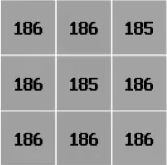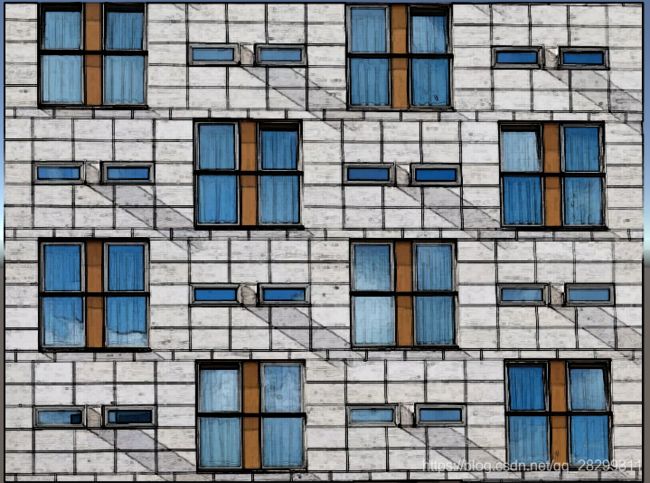Unity Shader - 边缘检测
边缘检测(英语:Edge detection)是图像处理和计算机视觉中的基本问题,边缘检测的目的是标识数字图像中亮度变化明显的点。图像属性中的显著变化通常反映了属性的重要事件和变化。这些包括(i)深度上的不连续、(ii)表面方向不连续、(iii)物质属性变化和(iv)场景照明变化。 边缘检测是图像处理和计算机视觉中,尤其是特征检测中的一个研究领域。
原理
边缘检测实质上就是通过对图像的卷积的结果,卷积是数学分析中一种重要的运算,主要区别在于卷积核的选择,通过卷积操作我们不仅可以做到边缘检测,还可以做到模糊图像、锐化图像等功能。
“模糊图像” 可以参考我的这篇文章
另外的描边 Shader可以参考这篇
边缘检测的卷积核 也叫做 边缘检测算子
如:Roberts Cross算子, Prewitt算子, Sobel算子, Canny算子,罗盘算子
这里以Sobel算子为例子:
G x = [ + 1 0 − 1 + 2 0 − 2 + 1 0 − 1 ] ∗ A G y = [ + 1 2 + 1 0 0 0 − 1 − 2 − 1 ] ∗ A G_x = \begin{bmatrix}+1&0& -1\\\\+2&0& -2\\\\+1&0& -1\end{bmatrix} *A \qquad G_y = \begin{bmatrix}+1&2&+1\\\\0&0& 0\\\\-1&-2& -1\end{bmatrix}*A Gx=⎣⎢⎢⎢⎢⎡+1+2+1000−1−2−1⎦⎥⎥⎥⎥⎤∗AGy=⎣⎢⎢⎢⎢⎡+10−120−2+10−1⎦⎥⎥⎥⎥⎤∗A
A {A} A代表原始图像, G x 和 G y G_x和 G_y Gx和Gy分别代表经横向及纵向边缘检测的图像,
通过以上公式就可以分别计算出横向 和 纵向 的梯度值,即 G x 和 G y G_x和 G_y Gx和Gy
梯度值越大,边缘就越明显。
注意:
- 计算梯度值前需要先把图像置灰,方便我们计算梯度值
- 横向的梯度值检测出来的是纵向的边缘线,纵向的梯度值检测出来的是横向的边缘线。
以上是理论,可能有些小伙伴看得很懵逼,下面我们举一个例子来说明一下:



假如上图是我们在图像上随机选取的两块3*3的像素块,以及横向的Sobel算子
像素块一的梯度值: G x 1 = 186 ∗ 1 + 186 ∗ 2 + 186 ∗ 1 − 233 ∗ 1 − 233 ∗ 2 − 232 ∗ 1 = − 187 G_{x1}=186*1 + 186*2 + 186*1 - 233*1- 233*2- 232*1=-187 Gx1=186∗1+186∗2+186∗1−233∗1−233∗2−232∗1=−187
像素块二的梯度值: G x 2 = 186 ∗ 1 + 186 ∗ 2 + 186 ∗ 1 − 185 ∗ 1 − 186 ∗ 2 − 186 ∗ 1 = 1 G_{x2}=186*1 + 186*2 + 186*1 - 185*1- 186*2- 186*1=1 Gx2=186∗1+186∗2+186∗1−185∗1−186∗2−186∗1=1
最后我们取他们的绝对值, 分别 187和1, 这里我们就很明显的看到了他们的区别,梯度值越大,说明该像素越有可能是边缘!
Shader 代码实现:
首先我们需要把图像置灰,置灰非常简单,通过灰度心理学公式 Gray = R*0.299 + G*0.587 + B*0.114 转换即可!
这里我们分别对横向和纵向做边缘检测,以便于我们做对比,理解。
创建一个C#脚本拖拽到摄像机上:
PS: PostEffectsBase 基类可以在我的这篇文章查看
或者到我的GitHub上获取
using UnityEngine;
using System.Collections;
//-----------------------------【边缘检测】-----------------------------
public class EdgeDetection : PostEffectsBase {
public Shader edgeDetectShader;
private Material edgeDetectMaterial = null;
public Material material {
get {
edgeDetectMaterial = CheckShaderAndCreateMaterial(edgeDetectShader, edgeDetectMaterial);
return edgeDetectMaterial;
}
}
[Range(0.0f, 1.0f)]
public float edgesOnly = 0.0f;
public Color edgeColor = Color.black;
public Color backgroundColor = Color.white;
void OnRenderImage (RenderTexture src, RenderTexture dest) {
if (material != null) {
material.SetFloat("_EdgeOnly", edgesOnly);
material.SetColor("_EdgeColor", edgeColor);
material.SetColor("_BackgroundColor", backgroundColor);
Graphics.Blit(src, dest, material);
} else {
Graphics.Blit(src, dest);
}
}
}
shader:(横向检测)
//-----------------------------【边缘检测】-----------------------------
Shader "lcl/learnShader3/002 Chapter 12/Edge Detection Test" {
//-----------------------------【属性】-----------------------------
Properties {
_MainTex ("Base (RGB)", 2D) = "white" {}
}
//-----------------------------【子着色器】-----------------------------
SubShader {
Pass {
ZTest Always Cull Off ZWrite Off
CGPROGRAM
#include "UnityCG.cginc"
#pragma vertex vert
#pragma fragment frag
sampler2D _MainTex;
uniform half4 _MainTex_TexelSize;
struct v2f {
float4 pos : SV_POSITION;
half2 uv[9] : TEXCOORD0;
};
//-----------------------------【顶点着色器】-----------------------------
v2f vert(appdata_img v) {
v2f o;
o.pos = UnityObjectToClipPos(v.vertex);
half2 uv = v.texcoord;
//计算周围像素的纹理坐标位置,其中4为原始点,
o.uv[0] = uv + _MainTex_TexelSize.xy * half2(-1, -1);
o.uv[1] = uv + _MainTex_TexelSize.xy * half2(0, -1);
o.uv[2] = uv + _MainTex_TexelSize.xy * half2(1, -1);
o.uv[3] = uv + _MainTex_TexelSize.xy * half2(-1, 0);
o.uv[4] = uv + _MainTex_TexelSize.xy * half2(0, 0); //原点
o.uv[5] = uv + _MainTex_TexelSize.xy * half2(1, 0);
o.uv[6] = uv + _MainTex_TexelSize.xy * half2(-1, 1);
o.uv[7] = uv + _MainTex_TexelSize.xy * half2(0, 1);
o.uv[8] = uv + _MainTex_TexelSize.xy * half2(1, 1);
return o;
}
// 转换为灰度
fixed luminance(fixed4 color) {
return 0.299 * color.r + 0.587 * color.g + 0.114 * color.b;
}
// sobel算子
half Sobel(v2f i) {
const half Gx[9] = {-1, 0, 1,
-2, 0, 2,
-1, 0, 1};
// const half Gy[9] = {-1, -2, -1,
// 0, 0, 0,
// 1, 2, 1};
half texColor;
half edgeX = 0;
half edgeY = 0;
for (int it = 0; it < 9; it++) {
// 转换为灰度值
texColor = luminance(tex2D(_MainTex, i.uv[it]));
edgeX += texColor * Gx[it];
// edgeY += texColor * Gy[it];
}
// half edge = 1 - abs(edgeX) - abs(edgeY);
half edge = abs(edgeX);
return edge;
}
//-----------------------------【片元着色器】-----------------------------
fixed4 frag(v2f i) : SV_Target {
half edge = Sobel(i);
return edge;
}
ENDCG
}
}
FallBack Off
}
最终结果对比
最后我们合并一下横向和纵向的边缘及原图,最终边缘检测结果为:
//-----------------------------【边缘检测】-----------------------------
Shader "lcl/learnShader3/002 Chapter 12/Edge Detection Test" {
//-----------------------------【属性】-----------------------------
Properties {
_MainTex ("Base (RGB)", 2D) = "white" {}
// 描边程度
_EdgeOnly ("Edge Only", Float) = 1.0
// 边缘颜色
_EdgeColor ("Edge Color", Color) = (0, 0, 0, 1)
}
//-----------------------------【子着色器】-----------------------------
SubShader {
Pass {
ZTest Always Cull Off ZWrite Off
CGPROGRAM
#include "UnityCG.cginc"
#pragma vertex vert
#pragma fragment frag
sampler2D _MainTex;
uniform half4 _MainTex_TexelSize;
fixed _EdgeOnly;
fixed4 _EdgeColor;
struct v2f {
float4 pos : SV_POSITION;
half2 uv[9] : TEXCOORD0;
};
//-----------------------------【顶点着色器】-----------------------------
v2f vert(appdata_img v) {
v2f o;
o.pos = UnityObjectToClipPos(v.vertex);
half2 uv = v.texcoord;
//计算周围像素的纹理坐标位置,其中4为原始点,
o.uv[0] = uv + _MainTex_TexelSize.xy * half2(-1, -1);
o.uv[1] = uv + _MainTex_TexelSize.xy * half2(0, -1);
o.uv[2] = uv + _MainTex_TexelSize.xy * half2(1, -1);
o.uv[3] = uv + _MainTex_TexelSize.xy * half2(-1, 0);
o.uv[4] = uv + _MainTex_TexelSize.xy * half2(0, 0); //原点
o.uv[5] = uv + _MainTex_TexelSize.xy * half2(1, 0);
o.uv[6] = uv + _MainTex_TexelSize.xy * half2(-1, 1);
o.uv[7] = uv + _MainTex_TexelSize.xy * half2(0, 1);
o.uv[8] = uv + _MainTex_TexelSize.xy * half2(1, 1);
return o;
}
// 转换为灰度
fixed luminance(fixed4 color) {
return 0.299 * color.r + 0.587 * color.g + 0.114 * color.b;
}
// sobel算子
half Sobel(v2f i) {
const half Gx[9] = {-1, 0, 1,
-2, 0, 2,
-1, 0, 1};
const half Gy[9] = {-1, -2, -1,
0, 0, 0,
1, 2, 1};
half texColor;
half edgeX = 0;
half edgeY = 0;
for (int it = 0; it < 9; it++) {
// 转换为灰度值
texColor = luminance(tex2D(_MainTex, i.uv[it]));
edgeX += texColor * Gx[it];
edgeY += texColor * Gy[it];
}
// 合并横向和纵向
half edge = 1 - (abs(edgeX) + abs(edgeY));
return edge;
}
//-----------------------------【片元着色器】-----------------------------
fixed4 frag(v2f i) : SV_Target {
half edge = Sobel(i);
fixed4 edgeColor = lerp(_EdgeColor, tex2D(_MainTex, i.uv[4]), edge);
edgeColor = lerp(tex2D(_MainTex, i.uv[4]),edgeColor, _EdgeOnly);
return edgeColor;
}
ENDCG
}
}
FallBack Off
}
最后
有兴趣的小伙伴可以来我的GitHub上逛逛,里面有我学习Shader过程中的一些记录,实现的一些特效,喜欢的可以点个Star,嘿嘿,谢谢啦!
